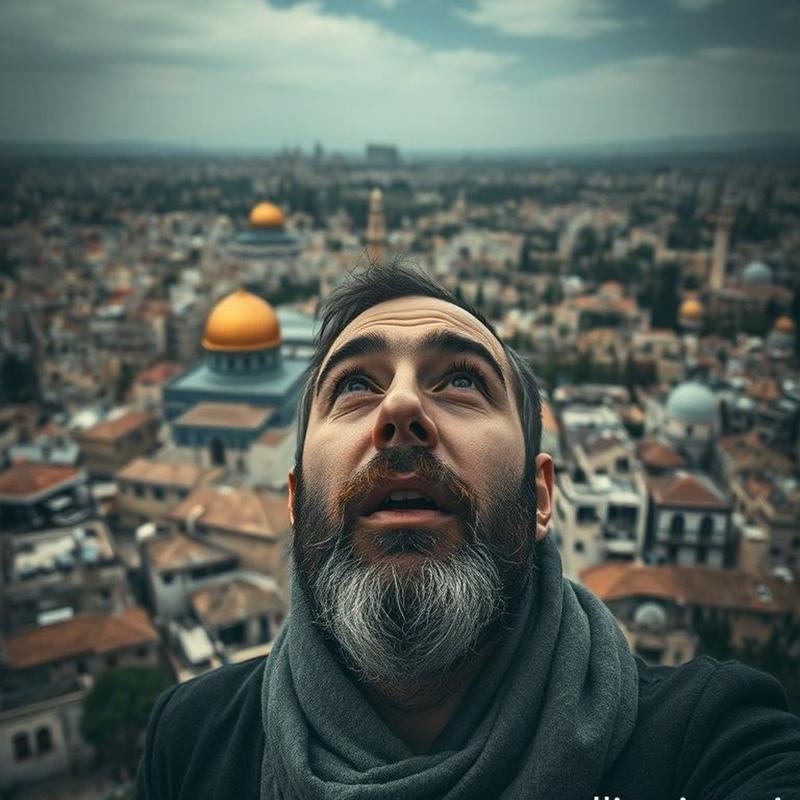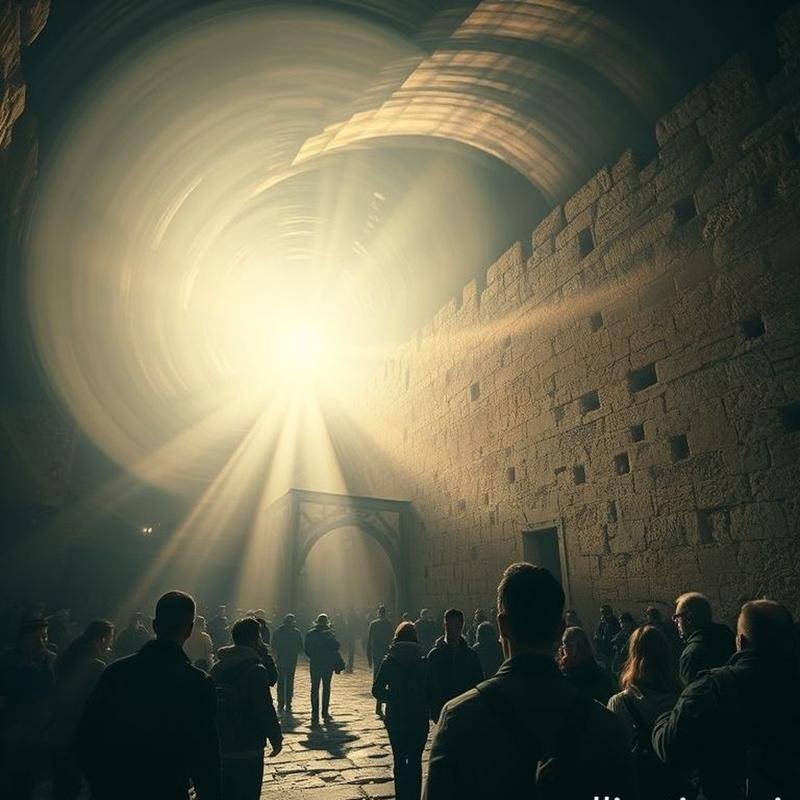Jerusalem Syndrome: The peculiar phenomenon in which tourists develop the belief that they are biblical figures.

Jerusalem Syndrome: Faith, Delusion, and the Holy City
In Jerusalem, a sacred city revered as a nexus between the earthly and divine realms, transformation extends beyond the spiritual quests of pilgrims. Here, some individuals unexpectedly experience what appears to be a living manifestation of prophecy, a phenomenon known as Jerusalem Syndrome. This is not a transient state of delusion, but a rare and peculiar condition that leads some to believe they are divinely appointed prophets or historical religious figures returned. The genesis of this conviction remains a subject of inquiry: Is it solely a psychological disorder, or does it stem from the city’s profound history, culture, and undeniable spiritual influence?
We will delve into this phenomenon, moving beyond media sensationalism to understand the underlying psychological and cultural factors. We will explore the potent influence of faith, the impact of a profound historical and religious context, and how a sacred place like Jerusalem can awaken latent forces, or perhaps, expose the vulnerabilities of the human mind. This is not merely a narrative of individuals succumbing to delusions of grandeur, but a story about faith, identity, and the arduous search for meaning in one of the world’s most symbolically charged locations.
Before we unravel this perplexing enigma, we invite you to share your expectations regarding this phenomenon in the comments. To follow our exploration, subscribe to our documentary channel.
Understanding Jerusalem Syndrome
Jerusalem Syndrome is not a mental illness in the conventional sense, as it is not formally recognized in psychiatric diagnostic manuals. Rather, it is a manifestation of a collection of unusual mental phenomena affecting some visitors to Jerusalem. Dr. Heinz Herman documented the initial cases in the 1930s, laying the groundwork for further investigation. Subsequently, Dr. Yair Bar-El classified the syndrome, identifying three distinct patterns: first, the exacerbation of pre-existing psychological disorders; second, the emergence of compulsive thoughts leading to unusual behaviors; and most notably, the third pattern, affecting individuals with no prior history of mental illness.
Each year, an estimated fifty to one hundred tourists require hospitalization in Jerusalem due to these symptoms. Manifestations include extreme anxiety, obsessive cleanliness, a compelling urge to wear clothing reminiscent of attire described in religious texts, and even the recitation of biblical verses in sacred locations. Individuals may embody religious figures, such as John the Baptist or the Virgin Mary, immersing themselves in the role as if participating in a sacred drama. Remarkably, the treatment is often straightforward: departure from Jerusalem. A return to a familiar environment is typically sufficient to restore normalcy.
However, the underlying drivers of this profound transformation remain a subject of inquiry. What are the root causes of this unique phenomenon?
The Confluence of Faith and History
Jerusalem is a city where the core tenets of the three Abrahamic religions – Judaism, Christianity, and Islam – converge. This intense spiritual confluence creates a focal point of conflicting and heightened emotions. The Haram al-Sharif, with the Al-Aqsa Mosque and the Dome of the Rock, captivates millions of Muslims. The Church of the Holy Sepulchre, where Christians believe in the crucifixion and resurrection of Jesus Christ, welcomes pilgrims from around the world. Adjacent to these sites, the Western Wall, the last vestige of the Second Temple, resonates with the prayers and supplications of Jews.
However, Jerusalem has not always been a haven of peace. The Crusades, marked by violence and religious cleansing, left indelible scars on the collective memory. In 1099, the Crusaders’ capture of the city was accompanied by massacres against Muslims and Jews, igniting anger and calls for retribution throughout the Islamic world. These historical events, among others, contribute to an emotionally and spiritually charged environment, potentially exacerbating psychological vulnerabilities and predisposing some individuals to Jerusalem Syndrome. Ongoing political and religious conflicts further contribute to this atmosphere of tension.
Types and Manifestations
Studies indicate that between 50 and 100 tourists annually experience symptoms of the syndrome, with approximately 40 requiring hospitalization. A significant proportion of these individuals have a pre-existing history of mental illness, such as schizophrenia or bipolar disorder. Dr. Eliyahu Witztum, a psychiatrist in Jerusalem, delineates three distinct types of the syndrome. The first type affects those with underlying mental health conditions. The second involves individuals with deeply rooted religious obsessions. The third, and perhaps most concerning, type involves psychologically normal individuals who experience psychosis as a result of the profound spiritual impact of Jerusalem.
Jerusalem, as some researchers suggest, is a city that exudes an immense emotional charge. This intense focus on sacred religious texts can lead to extreme literal interpretations, particularly among individuals with specific psychological predispositions. The 1982 arson attack on the Al-Aqsa Mosque by an Australian tourist, driven by overwhelming religious obsession, serves as a stark example.
Notable Cases and Challenges
Amid this tense atmosphere, Jerusalem Syndrome manifests in diverse and striking forms. In 2000, an American tourist became convinced that he was King Saul, roaming the streets in search of an army to lead against the Palestinians. In 1969, an Australian tourist, experiencing a powerful divine vision, created chaos at the King David Hotel, tearing sheets and disrupting furniture. While not all cases are as extreme, some individuals don white robes, believing they are John the Baptist, and embark on a search for disciples to baptize in the Jordan River. In 2012, a British woman was arrested at the Church of the Holy Sepulchre after declaring herself to be Mary Magdalene. Statistics indicate that approximately one hundred tourists annually require psychiatric hospitalization in Jerusalem due to this syndrome. Dr. Yair Bar-El confirms that symptoms typically subside upon departure from the city.
The impact of Jerusalem Syndrome extends beyond the affected individual. Police officers in Jerusalem, particularly during holiday seasons, face the challenge of distinguishing between devout believers and individuals experiencing mental health crises who believe they are the Messiah. A significant proportion of those affected, approximately 60%, have no prior history of mental illness, making it difficult to assess potential risks.
The Kfar Shaul Mental Health Center in Jerusalem receives between 50 and 100 such cases annually. These tourists present a unique challenge; some genuinely believe they are on a divine mission, as exemplified by the Australian tourist who attempted to destroy the Dome of the Rock. Treatment requires sensitivity. While not necessarily violent, these individuals are often severely disturbed, necessitating a delicate balance between medical care and security. This poses an ethical and legal dilemma: to what extent can one restrict the freedom of an individual who sincerely believes they are acting on divine instruction?
Treatment and Management
Even the most unusual phenomena offer opportunities for understanding. In managing Jerusalem Syndrome, extreme sensitivity is paramount. The primary objective is to gently remove the individual from the environment of Jerusalem and return them to a familiar setting, where the visions that captivated their imagination may fade. Initially, this may involve calmly containing the patient and observing them attentively, particularly if they pose a risk to themselves or others. In severe cases, antipsychotic medication may be necessary, but should be administered with caution, considering the patient’s cultural background and respecting their beliefs. Psychological and social support are essential for recovery. It is crucial to understand the individual’s beliefs without prejudice or belittlement. In some instances, involving clergy or spiritual leaders may provide valuable support and religious guidance. The ultimate goal is not merely treatment, but to restore the individual’s internal equilibrium and empower them to regain control of their life.
Conclusion: Beyond Sensationalism
Ultimately, Jerusalem Syndrome transcends sensationalism, revealing the profound influence of cultural and religious context on psychological experiences. While the term “Jerusalem Syndrome” emerged in the 1970s, its roots extend further back in medical literature. This phenomenon, affecting an estimated 50 to 100 tourists annually, is not specific to any single religion or culture, affecting individuals from Christian, Jewish, and Muslim backgrounds. It serves as a reminder of the importance of empathy and understanding when interacting with individuals experiencing mental health challenges. As Dr. Bar-El has explained, intense psychological pressure and deeply ingrained religious expectations can trigger or exacerbate underlying conditions. A 2000 analysis identified strong religious delusions as a common factor, particularly among Christians. Therefore, it is essential to move beyond superficial prejudices and strive to understand the complex interplay between history, culture, and psychology in shaping the human experience.
We have explored the psychological and cultural factors underlying Jerusalem Syndrome, moving beyond media sensationalism to understand the human experience and the power of belief within a specific historical and religious context. This phenomenon highlights the impact of the environment on the human mind and how a sacred place can trigger unique psychological states.
Following this exploration of Jerusalem Syndrome, what questions does this phenomenon raise regarding the relationship between faith and reason? Do you believe that holy places exert a psychological influence that transcends conscious perception? Share your thoughts and questions in the comments.
Video







